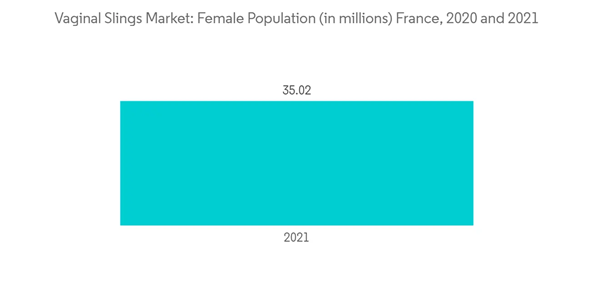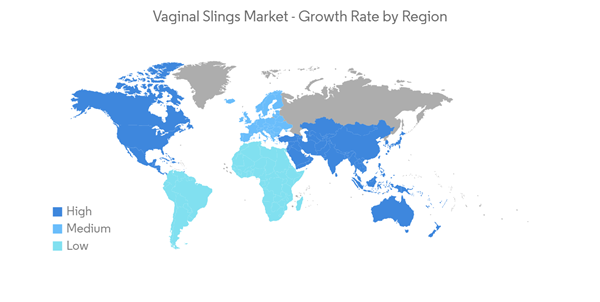Over the next few years, the vaginal slings market is expected to register a CAGR of 4.6%.
The COVID-19 pandemic had a substantial impact on women's health, both physically and emotionally. The strict lockdowns and government regulations intended to slow down the spread of COVID-19 resulted in a decrease in demand for products across all segments. According to an article published in February 2021, urogynecological patients face particular challenges owing to the inherent vulnerabilities of these populations. Behavioral and medical therapies should be recommended as first-line options and initiated via virtual or remote clinics, which were integral to management during the COVID-19 pandemic. Thus, the COVID-19 outbreak had a negative impact on the vaginal sling market. However, the vaginal sling market is expected to grow during the forecast period due to the increasing prevalence of urinary incontinence, the rise in the geriatric population, and the high demand for minimally invasive surgeries.
According to another article published in the Wiley Online Library in February 2021, with the increase in research, some of the neurological complications that were reported in COVID-19 patients include headache, anosmia, hyposmia, dysgeusia, impaired consciousness, seizures, encephalitis, and demyelinating neuropathy. Inflammation and demyelination in the pudendal nerve can lead to bladder and bowel incontinence. Thus, more patients were diagnosed with urinary inconsistency during the COVID-19 era.
The major factor contributing to the growth of the market is the rising prevalence of urinary incontinence. Numerous factors, such as urinary tract infection, weakening of pelvic floor muscles and urethral sphincters, menopause, pregnancy, and childbirth, lead to the development of urinary incontinence symptoms. For instance, according to an article published in the National Library of Medicine in October 2021, the most common urinary tract infections reported in the elderly population are cystitis (37.6%), followed by asymptomatic bacteriuria (31.9%), pyelonephritis (13.9%), urosepsis (10.2%), and prostatitis (6.4%). Thus, the rising prevalence of urinary tract infections will boost the market in the future.
Furthermore, rising demand for minimally invasive procedures and increasing technological advancements boost the market's growth. The major impediment to market growth, however, is the social stigma associated with the disease, as well as the risks and complications associated with the procedures involving these devices.
Apart from the benefits of the slings, other factors that boost segment growth are the increasing prevalence of urinary incontinence in women and the increasing geriatric population, which is more susceptible to these symptoms. For instance, according to an article published in BMC Geriatric in May 2022, urinary incontinence in older adult women is about 37.2% worldwide. The highest prevalence of urinary incontinence was reported in older adult women in Asia, at 45.1%. As a result, rising prevalence will favor market growth in the coming years.
Thus, the increasing prevalence of urinary incontinence in women and the increasing demand for minimally invasive procedures are propelling segment growth.
Furthermore, well-established insurance policies and the availability of advanced healthcare infrastructure are a few of the other factors boosting the market in this region. In 2021, the Biden Administration launched $500 million in funds from the American Rescue Act with the objective of helping rural hospitals and supporting the renovation and construction of rural healthcare facilities. Developments such as these, along with the gradual increase in demand for minimally invasive surgery in United States hospitals, are also likely to propel the overall market dynamics in the upcoming years.
Therefore, the presence of a larger patient pool, well-established insurance policies, and an increasing geriatric population are expected to boost the growth of the studied market in the North American region.
This product will be delivered within 2 business days.
The COVID-19 pandemic had a substantial impact on women's health, both physically and emotionally. The strict lockdowns and government regulations intended to slow down the spread of COVID-19 resulted in a decrease in demand for products across all segments. According to an article published in February 2021, urogynecological patients face particular challenges owing to the inherent vulnerabilities of these populations. Behavioral and medical therapies should be recommended as first-line options and initiated via virtual or remote clinics, which were integral to management during the COVID-19 pandemic. Thus, the COVID-19 outbreak had a negative impact on the vaginal sling market. However, the vaginal sling market is expected to grow during the forecast period due to the increasing prevalence of urinary incontinence, the rise in the geriatric population, and the high demand for minimally invasive surgeries.
According to another article published in the Wiley Online Library in February 2021, with the increase in research, some of the neurological complications that were reported in COVID-19 patients include headache, anosmia, hyposmia, dysgeusia, impaired consciousness, seizures, encephalitis, and demyelinating neuropathy. Inflammation and demyelination in the pudendal nerve can lead to bladder and bowel incontinence. Thus, more patients were diagnosed with urinary inconsistency during the COVID-19 era.
The major factor contributing to the growth of the market is the rising prevalence of urinary incontinence. Numerous factors, such as urinary tract infection, weakening of pelvic floor muscles and urethral sphincters, menopause, pregnancy, and childbirth, lead to the development of urinary incontinence symptoms. For instance, according to an article published in the National Library of Medicine in October 2021, the most common urinary tract infections reported in the elderly population are cystitis (37.6%), followed by asymptomatic bacteriuria (31.9%), pyelonephritis (13.9%), urosepsis (10.2%), and prostatitis (6.4%). Thus, the rising prevalence of urinary tract infections will boost the market in the future.
Furthermore, rising demand for minimally invasive procedures and increasing technological advancements boost the market's growth. The major impediment to market growth, however, is the social stigma associated with the disease, as well as the risks and complications associated with the procedures involving these devices.
Vaginal Slings Market Trends
Transobturator Slings is Expected to Dominate the Vaginal Slings Market
Transobturator slings are expected to dominate the vaginal slings market due to their decreased risk of bladder injury, bowel injury, and major blood vessel injury, ease of the procedure, and efficacy equivalent to tension-free vaginal tape slings. For instance, according to an article published in Pubmed in November 2021, single-incision mini-slings are a safe and effective treatment for female urodynamic stress incontinence. The Solyx single-incision slings demonstrated superiority over the MiniArc in this study based on their higher objective cure rate and lower risk for surgical failure. Thus, the advantages of transobturator slings will boost market growth in the future.Apart from the benefits of the slings, other factors that boost segment growth are the increasing prevalence of urinary incontinence in women and the increasing geriatric population, which is more susceptible to these symptoms. For instance, according to an article published in BMC Geriatric in May 2022, urinary incontinence in older adult women is about 37.2% worldwide. The highest prevalence of urinary incontinence was reported in older adult women in Asia, at 45.1%. As a result, rising prevalence will favor market growth in the coming years.
Thus, the increasing prevalence of urinary incontinence in women and the increasing demand for minimally invasive procedures are propelling segment growth.
North America is Expected to Dominate the Vaginal Slings Market
North America is expected to dominate the overall vaginal sling market throughout the forecast period. The largest share is mainly due to the presence of a larger patient pool and an increasing geriatric population. For instance, according to an article published in the NIH in June 2021, bothersome stress, urgency, and mixed incontinence were reported by 6.7%, 4.8%, and 19.3% of women, respectively, and by 0.6%, 3.5%, and 1.9% of men, respectively. Among chronic conditions, heart failure was associated with a higher prevalence of mixed incontinence in women and urgency incontinence in men. Thus, a higher prevalence of diseases will favor the growth of the market in the future.Furthermore, well-established insurance policies and the availability of advanced healthcare infrastructure are a few of the other factors boosting the market in this region. In 2021, the Biden Administration launched $500 million in funds from the American Rescue Act with the objective of helping rural hospitals and supporting the renovation and construction of rural healthcare facilities. Developments such as these, along with the gradual increase in demand for minimally invasive surgery in United States hospitals, are also likely to propel the overall market dynamics in the upcoming years.
Therefore, the presence of a larger patient pool, well-established insurance policies, and an increasing geriatric population are expected to boost the growth of the studied market in the North American region.
Vaginal Slings Market Competitor Analysis
The vaginal slings market is moderately competitive, with market players focusing on various strategies such as product advancement, invention, acquisitions, and mergers. Some of the companies that are currently dominating the market are Boston Scientific Corporation, Coloplast Corp., Promedon Group, A.M.I. GmbH, Johnson & Johnson, Betatech Medical, Caldera Medical, and ABISS.Additional benefits of purchasing the report:
- The market estimate (ME) sheet in Excel format
- 3 months of analyst support
This product will be delivered within 2 business days.
Table of Contents
1 INTRODUCTION
4 MARKET DYNAMICS
5 MARKET SEGMENTATION
6 COMPETITIVE LANDSCAPE
Companies Mentioned (Partial List)
A selection of companies mentioned in this report includes, but is not limited to:
- Coloplast Corp
- Promedon Group
- A.M.I. GmbH
- Johnson & Johnson
- Betatech Medical
- Caldera Medical
- CR Bard Inc.
- Boston Scientific Corporation
Methodology

LOADING...










